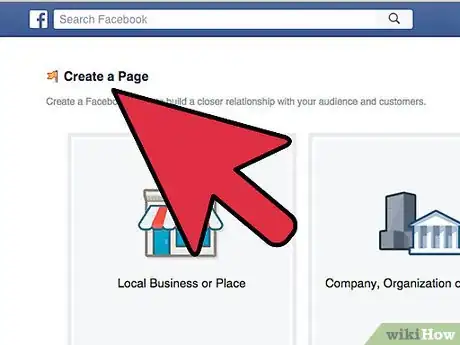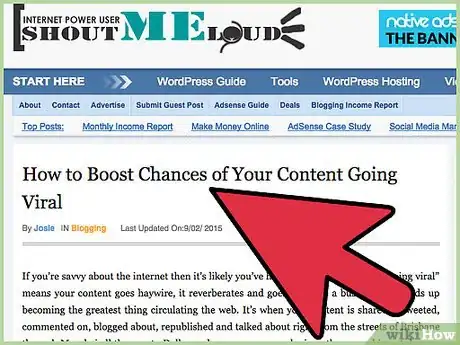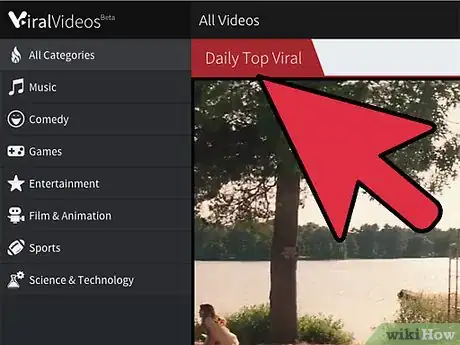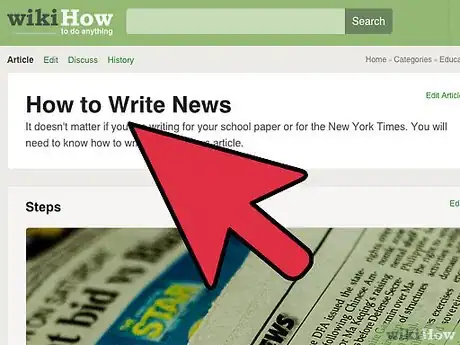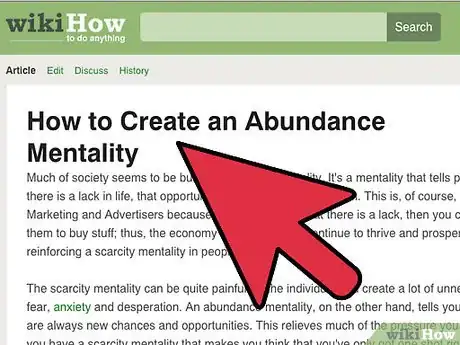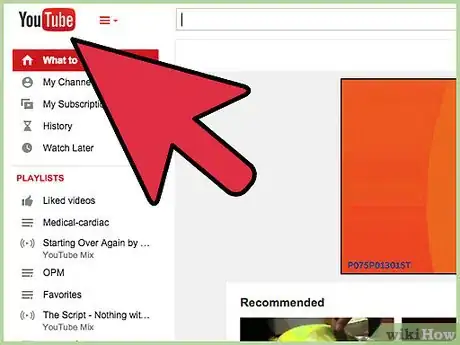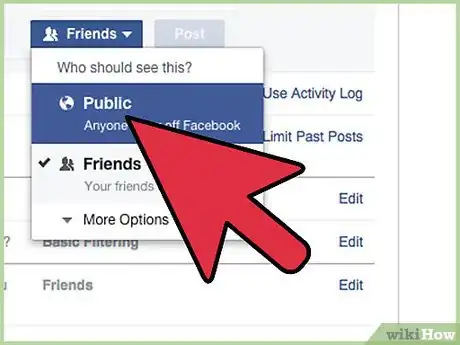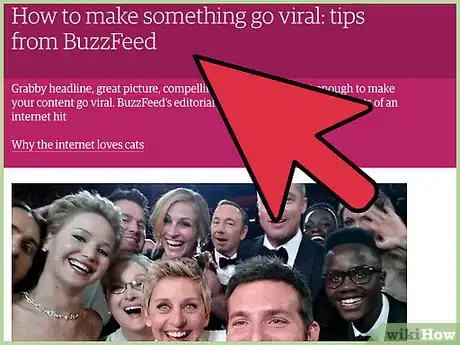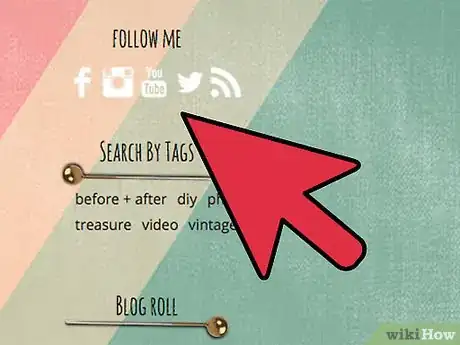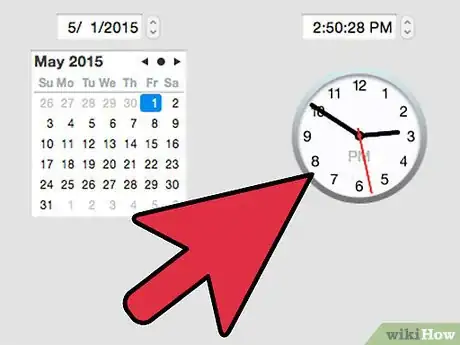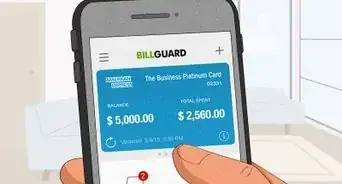wikiHow is a “wiki,” similar to Wikipedia, which means that many of our articles are co-written by multiple authors. To create this article, 35 people, some anonymous, worked to edit and improve it over time.
There are 7 references cited in this article, which can be found at the bottom of the page.
This article has been viewed 301,769 times.
Learn more...
Almost everyone who's savvy with the internet has heard about "going viral".[1] "Going viral" refers to the fact that your content resonates so enormously that it catches on fire, and ends up being the latest big thing across the internet. It is when your content gets liked, retweeted, republished, commented on, blogged about, talked about on the streets of LA to Viti Levu, and it earns you more views than your wildest dreams could ever have imagined.
It's a powerful outcome for your web content and for your brand's reputation (even if that brand is "you"). However, desiring the key to making something go viral is an unrealistic wish; certainly, you should do your best to make your content the most interesting and fascinating online experience possible, but nobody can really put their finger on what causes something to "go viral". What you can do is improve your chances of achieving a viral outcome while accepting that much of going viral is going to be about luck and good fortune.
Steps
-
1Appreciate the varying degrees of "going viral". Your website content, photos, or a video you've created can "go viral", your marketing can turn viral ("viral marketing"), and in the case of social media, a blog, a Facebook page or group, or a tweet can turn viral. In fact, any sort of content you create that is shared via phones, iPads, computers, or other electronic means can be viral, be it an app, game, puzzle, or a story, so don't limit your idea of what can go viral to thinking about dancing baby videos or million pixel websites! The next great viral thing is... unknown!
- Viral could mean within your interest niche, such as just among photography buffs, cooking fans, Star Wars collectors, or whatever, or it could go beyond your niche into the stratosphere of being enjoyed and shared around by everyone, just because there is something within your content that resonates with a wide group of people, such as a human interest element, a problem solved, a health scare, a video or story of a cute kid or pet, etc.
-
2Understand the limits of going viral. It's a good idea to get this straight before getting too excited – you cannot make your content go viral. You can hope for it, you can position your content to be at its best and most interesting with the underlying wish that it will catch on, but you cannot make it go viral. At the most, as Ann Handley and C.C. Chapman explain in their book Content Rules, you can "nudge, poke, and pray for it ... [but] the truth is that viral is largely a happy accident."[2] So, don't try to control the viral nature of your content; instead, concentrate fully on making it compelling, at the top of its niche, interesting, funny, moving, and definitely something able to resonate with a lot of readers or viewers. Accept that it will be your audience who makes the ultimate decision on the content's "viral worthiness".Advertisement
-
3Know what flows. One of the key things behind something going viral is that it touches people in some way. And what is most likely to touch a bunch of people who are tech-savvy, clued in, and ready for new information all of the time? Unsurprisingly, it's the same as it has always been – things that are uplifting and make us feel good about ourselves and others. What is most likely to "flow" – that is, get sent around the social media networks – is content of the following nature:[3]
- Content that inspires awe. Think of "Christian the Lion".[4] Can you still get over the fact that two guys could even buy a lion cub in a large department store in the middle of one of the world's biggest cities (Harrods) once upon a time, and that that lion could then frolic in local London gardens before being shipped to Africa and still recognize his original owners years later? That sort of awe-inspiring tale gives us all a sense of how amazing this world is and how we can all play intricate, valuable roles in life.
- Content that triggers an emotional response.
- Positive articles, positive, uplifting messages. Articles able to open the mind and broaden knowledge through positive messages are particularly enjoyed.
- Articles that make us feel good about ourselves and others. One viral event that created a real feel good sense was the video "Validation",[5] in which people saw the good that comes of validating other people. Articles that that create a sense of admiration and surpassing of mere self-interest tend to be the most shared, showing that we do care a great deal about others and we're moved by stories of others who are actively doing something to show this.
- Longer articles over short. Believe it or not, people will spend time reading thoroughly when the content merits it, and when it carries a clear message that they're yearning to learn more about. Just be sure that longer means "more engaging" and not "long-winded and repetitive"!
- Quirky topics, especially the "unexpected". Things that are out-of-the-ordinary, very unusual, and extremely interesting.
- Cute things. Laughing babies, crazy cats, dogs doing tricks, etc. – we've all watched or seen such content and loved it.
-
4Have value, perceived or otherwise. Some examples of information that helps others improve their lives, understand things better, or make timely decisions include:
-
5Have an abundance mentality. Information used to be something carefully protected and meted out to the masses. These days, it's about sharing information as much as possible, although not just any information but useful, quality, informative, and even detailed information that people really need or want to make their lives better. The person, company, or group most willing to provide quality information to others that shares or solves something and doesn't involve a secret agenda (such as sales or demands) is most likely to get respected followings, which enhances the chances of turning viral.[6] However, be wary of how you promote this vast amount of productivity; see below for avoiding overdoing the promotion.
-
6Make sure people can find your content. Content that's buried and difficult to access won't go viral for the simple fact that nobody can find it. Start with your domain or host; if you have your own domain, is it an easy-to-remember name or one that requires the memory of an elephant to get right? If you're using another site to host your content, be sure to use one that has a good following, such as Flickr, YouTube, Vimeo, or Facebook, etc. And be sure that your content includes the very thing people would be looking for, such as a turn of phrase, a precise question, specific keywords, etc.
- Search for your content using a search engine or two. Is it coming back to you easily or are you having to dig through page after page of returns before it shows up?
- Use social media as another string to your bow. Active Facebook and Twitter accounts are the place to leave information about freshly uploaded content and to encourage the information to be shared around widely.
- Provide easy search and categorization within your content so that people can find things quickly if they do want to look through more than one piece of content. Moreover, search engines love categories.
- Tag and keyword everything you can. Search engines can find the content better this way.
-
7Publicize yourself. While it isn't possible to create a viral outcome, it is possible to encourage the potential for it. Publicizing your content through trusted channels is an important way to get your content seen, noticed, and possible picked up on by many others. In other words, make it very easy for people to notice that your content is there.
- Put your content on more than one site. Use Twitter, Facebook, YouTube, RSS feeds, microblogging sites, and even links via profile pages you have on various websites and your email signatures. Get onto forums, into IRCs, and anywhere else you usually frequent and casually mention your masterpiece and suggest that people might check it out.
- Use a link. The majority of retweets have links in them. When it comes to viral videos and webpages, the link is a crucial part of it.
- Send a link to your content to everyone you know such as friends, family, and co-workers, provided it's not likely to be a nuisance to them.
-
8Don't overdo your content promotion. Be very selective about what you encourage your readers and viewers to check out. You don't want to convince them that every single piece of content you produce is the next latest greatest thing or they'll start viewing you as the "boy who cried wolf" and stop even looking at your work. Be astute about what is the very best of your output and only put that forward as worthy of getting shared around. That way, you increase the chances of going viral because it's both quality content and not about over-pressuring your initial content sharers.
-
9Create momentum and incite action. Not only should you publicize yourself but you need to also help your viewers and readers do something with your content; it isn't enough to simply put the content out and sit about hoping something will eventuate. Plant the suggestion for them and allow them to be the arbiter of whether or not they'll follow through. For example, if you want to be retweeted, just ask. And be sure to try that six letter word, 'please'. A higher percentage of retweets are found to contain the word "please" than not! Some ways to provide a call to action include (and the more of these you can do, the better):
- Providing clear social sharing icons, such as Facebook, Twitter, LinkedIn, Google Reader, etc. These icons are fondly known as "social bling" and since they increase the ease with which people can pass around your content, make the most of them.
- Tell people what you're hoping to happen with the content by gently steering them with kind and thoughtful requests. Some of the ways to do this include saying such phrases as:
- Check out… (my link, my eBook, my post, my video, my article, etc.)
- Please embed my video/interactive quiz… (and make it easy for this to happen)
- Follow this person
- Download my widget/game/PowerPoint/eNook!
- Please vote!
- Help me...
- Questions, e.g. “What do you think of…?", and so forth.
- Invite people to come and interact with you, your content, or something you've created around the content. Perhaps a webinar, or a Skype call, or a Twitter party. Be open to all the possibilities to enlighten people as to the potential for your content.
-
10Watch your timing. As with most things in life, timing is everything and you need to have a sense of whether or not the time is right for the content you're hoping to go viral. If it's not, patience might be a virtue until the right moment appears but if it is, then don't waste a moment in case someone else gets there ahead of you. Only you will be able to gauge the issue of timing as it will be very attuned to your topic and interests and is something you will need to monitor the pulse of yourself.
- In terms of timing the posting itself, this is a related but slightly different issue. Be sure to post at what you know is the most active time of being online for your target audience. The more people who are actively reading, viewing, or interacting with your content at the same time when it's released, the greater are your chances of the content getting sent around amid the buzz of novelty and mutually sustaining sharing.
-
11Leave room for connection. Ultimately it is the ability for conversation to take place that helps many a piece of web content to turn viral. Make sure it's easy for people to contact you if they want to know more, either through comment boxes, IM, a chat forum, an email, or any other way you're used to using. And be responsive, not reclusive!
- Ratings systems can be helpful too, as can numbers of visitors. These do influence readers and viewers who can see what others are thinking about the content and how many other people are getting involved.
Community Q&A
-
QuestionHow can I go viral on Instagram?
 Ollie PottertonCommunity AnswerAdd multiple tags to your posts so they will be more visible. Try becoming friends with well known people on Instagram, maybe they will give you a shout-out.
Ollie PottertonCommunity AnswerAdd multiple tags to your posts so they will be more visible. Try becoming friends with well known people on Instagram, maybe they will give you a shout-out.
Warnings
- Not everything that you think will go viral will. Accept that and be honest with yourself about the value, quality, and worthiness of the content in the first place.⧼thumbs_response⧽
- Avoid engaging in magical thinking; this will prevent you from putting in the much-needed effort to make your content worthwhile.⧼thumbs_response⧽
Things You'll Need
- Top quality content.
- Content with a fresh, interesting, positive, and quirky angle.
- Research and knowledge about your target audience.
- Knowledge about your topic and its currency.
References
- ↑ Wikipedia, "Viral phenomenon", http://en.wikipedia.org/wiki/Viral_phenomenon
- ↑ Ann Handley and C.C. Chapman, Content Rules, p. 113, (2011), ISBN978-0-470-64828-5
- ↑ Ann Handley and C.C. Chapman, Content Rules, pp. 104-106, (2011), ISBN978-0-470-64828-5
- ↑ http://en.wikipedia.org/wiki/Christian_the_lion
- ↑ http://www.youtube.com/watch?v=Cbk980jV7Ao
- ↑ Ann Handley and C.C. Chapman, Content Rules, p. 70, (2011), ISBN978-0-470-64828-5
- The original idea for this article inspired by, Going Viral, http://www.copyblogger.com/go-viral-on-twitter/.
